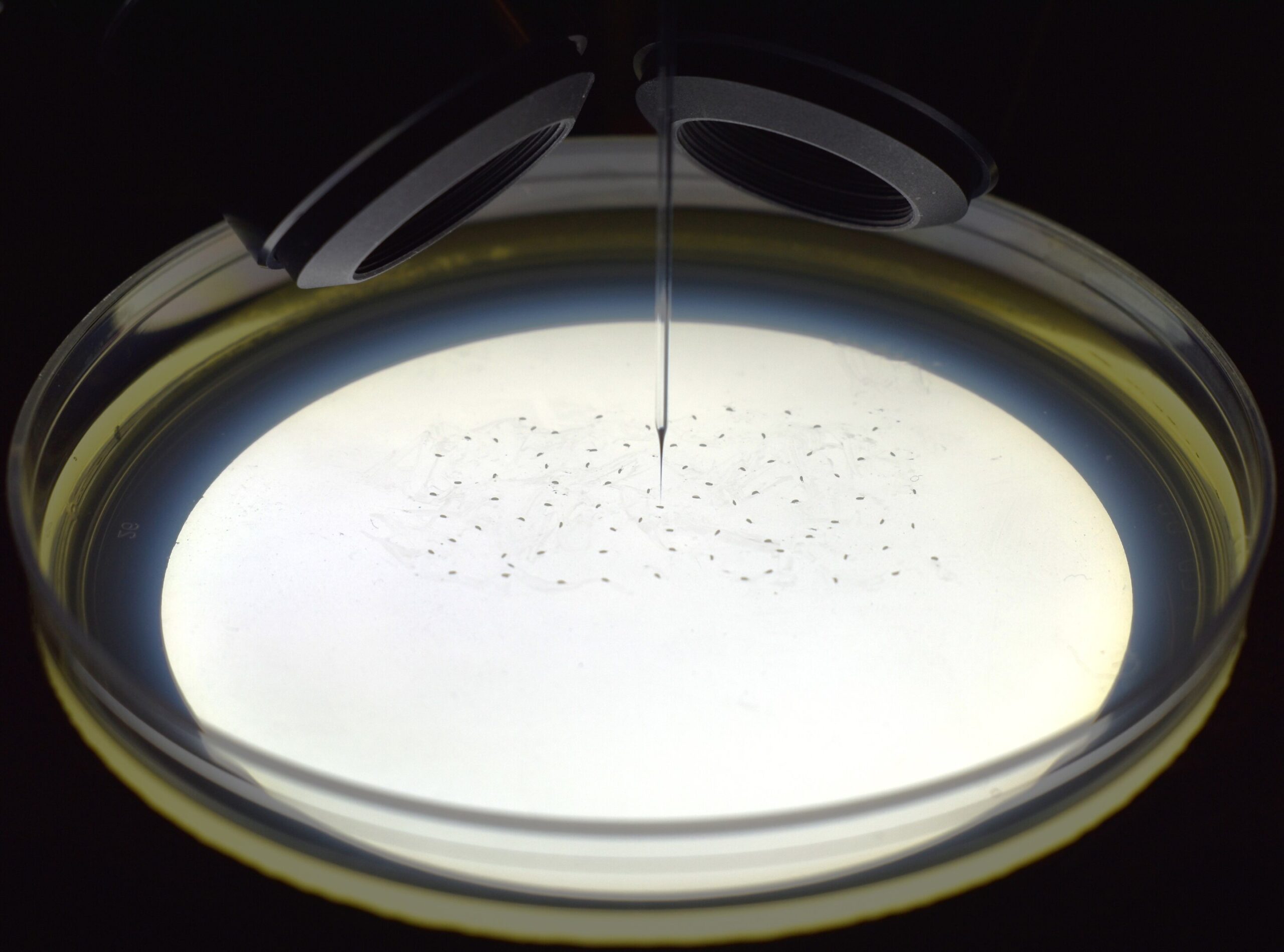The microinjection robot detects embryos the size of a hundredth of a grain of rice, calculates a path, and automates the process. Credit: Andrew Alegria, University of Minnesota Twin Cities
x to close
The microinjection robot detects embryos the size of a hundredth of a grain of rice, calculates a path, and automates the process. Credit: Andrew Alegria, University of Minnesota Twin Cities
Researchers at the University of Minnesota Twin Cities have developed a robot that uses machine learning to fully automate the complex microinjection process used in genetic research.
In their experiments, researchers were able to use this automated robot to manipulate the genetics of multicellular organisms, including fruit flies and zebrafish embryos. The technology saves labs time and money while enabling them to more easily perform large-scale new genetic tests that were previously not possible using manual techniques.
The research, titled “High-Throughput Genetic Manipulation in Multicellular Organisms Using a Machine Vision-Guided Embryo-Injection Microrobot,” is published on the cover of the April 2024 issue. Genetics, an open access journal. This was done by two University of Minnesota mechanical engineering graduate students, Andrew Alegria and Amy Joshi. The team is also working to commercialize the technology to make it widely available through a University of Minnesota startup, Objective Biotechnology.
Microinjection is a method of introducing cells, genetic material, or other agents directly into embryos, cells, or tissues using a very fine pipette. Researchers have trained this robot to recognize embryos as small as a hundredth of a grain of rice. Once detected, the device can calculate a route and automate the injection process.
“This new process is more robust and reproducible than manual injection,” said Suhasa Kodandaramaiah, associate professor of mechanical engineering at the University of Minnesota and senior author of the study. “With this model, individual labs will be able to think of new experiments that you couldn’t do without this type of technology.”
Typically, this type of research requires highly skilled technicians to perform microinjections, which many laboratories lack. This new technology could increase the ability to perform large-scale experiments in laboratories while reducing time and costs.
Daryl Goll, one of the researchers, said: “This is very exciting for the world of genetics. Writing and reading DNA has improved tremendously in recent years, but having this technology gives us the ability to do large-scale genetic experiments across the spectrum. It increases a wide range of organisms.” One of the authors of this study, the leader of the University of Minnesota Genomics Center Innovation Laboratory and a research assistant professor in the Department of Genetics, Cell Biology and Development.
Not only could this technology be used in genetic experiments, it could also help preserve endangered species through cryopreservation, a procedure performed at extremely low temperatures.
“You can use this robot to inject nanoparticles into cells and tissues, which will help preserve the freezing and then the rewarming process,” Kodandaramaiah explained.
Other team members highlighted other uses for the technology that could have more impact.
“We hope that this technology can eventually be used for in vitro fertilization, where you can identify those eggs on a microscopic scale,” said Andrew Alegria, the paper’s lead author and a University of Minnesota mechanical engineering graduate research assistant at Biosensing. ” and biorobotics laboratory
In addition to Kodandaramaiah, Gohl, Alegria and Joshi, the team included several researchers from the University of Minnesota College of Science and Engineering and the University of Minnesota Genomics Center Innovation Lab. The team recently won the university’s “Walleye Tank” bioscience competition. The Life Sciences Land Competition provides educational and promotional opportunities for emerging and established medical and life sciences companies.
This research was completed in collaboration with the Engineering Research Center for Advanced Technologies for the Conservation of Biological Systems (ATP-Bio) and the University of Minnesota Zebrafish Core.
more information:
Andrew D’Alegria et al., High-Throughput Genetic Manipulation in Multicellular Organisms Using a Machine Vision-Guided Embryo Microinjection Robot, Genetics (2024). DOI: 10.1093/genetics/iyae025
Magazine information:
Genetics
#Automated #machine #learning #robot #opens #potential #genetics #research
